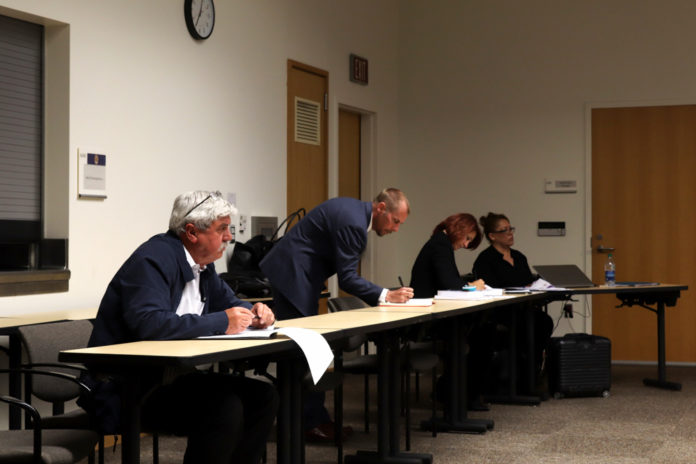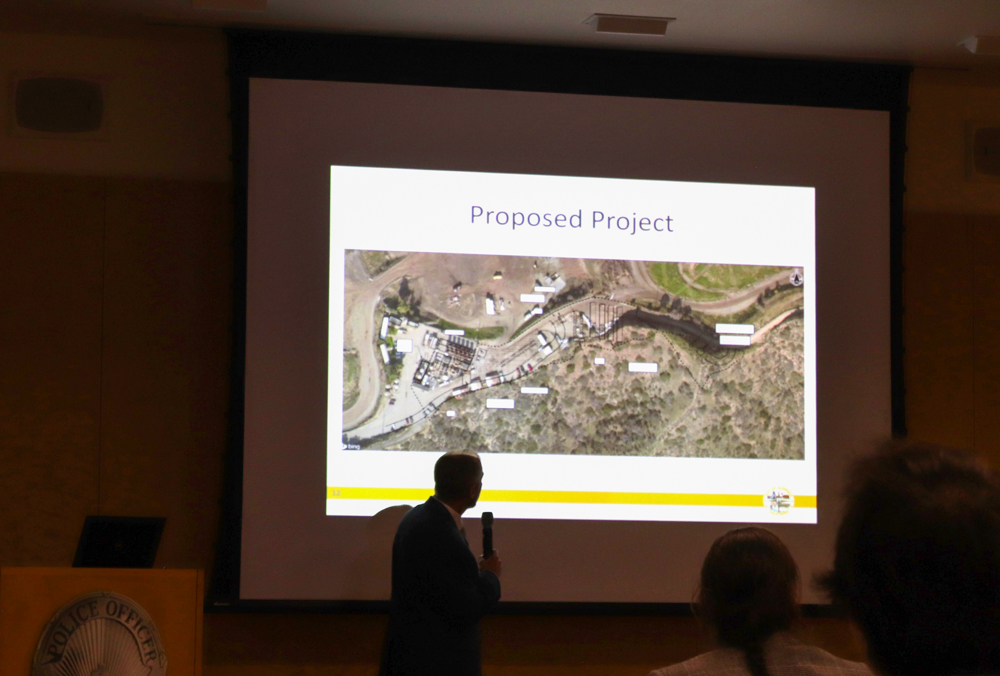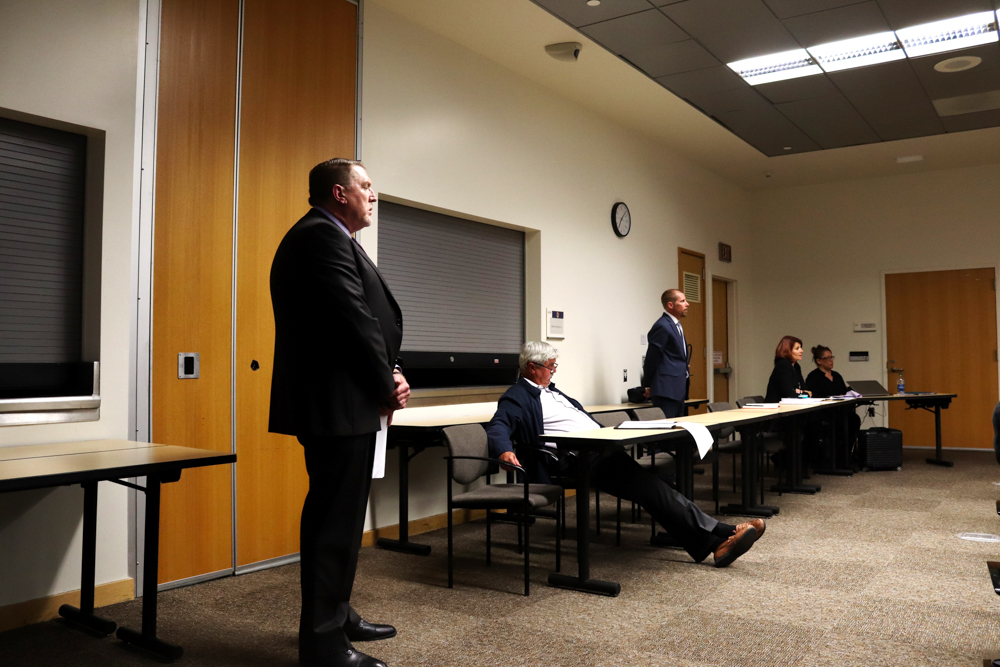
At two public input meetings April 4, residents of Glenoaks Canyon, Glendale, Eagle Rock and other residential areas near to the Scholl Canyon Landfill expressed their concerns about Glendale Water and Power‘s (GWP) proposed biogas facility, which would convert the landfill’s gas emissions, including methane, into electricity. GWP is in the early stages of drafting an environmental impact report (EIR) for the project, after being ordered to do so March 21, 2018, by the Glendale City Planning Commission. The Planning Commission decided to require an EIR after rejecting GWP’s Mitigated Negative Declaration — a less extensive risk assessment measure — citing resident’s concerns. Meeting attendees also voiced their concern about recent revelations that GWP has been flaring the landfill gas without informing residents since April 2018.
At the second of the two meetings April 4, which was attended by about 30 people, 13 residents gave public comments. GWP Environmental Program Administrator Maurice Oillataguerre said the comments from the two meetings will be taken into account during the drafting of the EIR, which will be conducted by the consulting firm Stantec and overseen by GWP officials. Residents’ concerns included air and water pollution, the proximity of the site to active fault lines, the location of the landfill in a high-risk zone for fires, noise pollution and negative effects on local wildlife.
Resident Linda Pillsbury’s comments focused on the project’s potential air pollution. She warned of nitrogen oxide emissions eight times the level allowed by the local Air Quality Management District (AQMD), emissions of polycyclic aromatic hydrocarbons and particulate matter emissions at three times the threshold level set by the AQMD. She also asked for air quality monitors to be placed closer to the site. Oillataguerre said GWP’s estimates on the air quality effects from the proposed plant will be available once the draft EIR is completed. He noted that the air quality monitors are managed by the LA County Sanitation District.
Eileen Hatrick, a former Dahlia Heights Elementary School principal who lives in Eagle Rock, said she was concerned about the proposed project’s proximity to homes, schools and recreational areas, such as Eagle Rock Hillside Park.
“Is this project in an industrial or municipal wasteland or is it in a densely-populated area?” Hatrick asked.
Hatrick said she had personally made informal measurements of the distance between the landfill and nearby schools, parks and residential areas. According to her, there are 18 schools and three hospitals within a 2-mile radius of the site, with three of those schools — and a total of 800 students — within a 1-mile radius.
“It’s really all about the location,” Hatrick said.
Claudia Puig lives in Glenoaks Canyon, a 750-home community that is less than half a mile away from the landfill. In her comments at the meeting, she focused on the proximity of the proposed plant to fault lines, citing information from another Glenoaks Canyon resident, Clarence Hall, a geology professor at UCLA. Puig said there are six active fault lines within a 10.5 mile radius of the gas site and four active faults within a five mile radius.
“We know, given what USGS and what all kinds of experts have been saying, we’re going to have an earthquake. Whether it’s going to be in the next couple of years or the next 20 years, we don’t know,” Puig said. “But that landfill is going to be there. The idea of gas also being there could really, you know — I would guess there would be fire possibilities.”
At the second public input meeting, resident Audry Zarokian used her comments to discuss the risk of fire at or near the proposed facility. According to a fire zone map on the LA Fire Department website, there is a high fire-hazard zone that stretches from the outer southern limits of the landfill, across the Ventura Freeway, and into parts of Eagle Rock. Zarokian expressed her concern over the electricity infrastructure that would be added for the biogas plant. She said that electric companies’ equipment have caused many fires in California — the 2017 Thomas fire was caused by Southern California Edison power lines, the 2018 Camp Fire was likely caused by Pacific Gas & Electric equipment and the 2007 Witch fire was caused by San Diego Gas & Electric power lines.
Oillataguerre said that although the site may be near a fire zone, he does not believe the project will increase fire risk in the area. He said the project would include a 60,000 gallon water tank specifically for fire suppression, which could fight fires with a sprinkler system.
“Fire was always a concern for everybody. I mean, we live in a very dry area, but as far as the danger presented by the proposed facility, I mean, it’s going to be enclosed,” Oillataguerre said. “We don’t see there being really that high — it’s not going to really increase the fire risk up there.”
Marie Freeman, a Glenoaks resident who gave two public comments at the second April 4 meeting, said what upsets her and other residents most is what she sees as a lack of transparency from GWP. She believes that when GWP started flaring off the gas in April 2018, they should have informed residents.
“I think what really pissed us off more than anything else was that we didn’t know about it for so long,” Freeman said. “Had they been more transparent about it, I think it wouldn’t have been so bad.”

According to Oillataguerre, GWP legally had to flare the gas once it stopped piping it to the Grayson Power Plant, which had been the default destination for the gas since the pipeline was built in 1994. The Pasadena Star News reported that GWP stopped piping the gas to the Grayson plant because the outdated combustion equipment there was causing unsafe levels of emissions. Mark Young, integrated resources planning administrator for the City of Glendale, said that now that the pipeline is not in use it would be environmentally worse to not flare the gas.
“You have to manage the gas, right? You can’t just leave it alone,” Young said. “Because the methane is ten times worse than any carbon component. So you have to manage it. We’re required to.”
Oillataguerre said the flares were installed in the 1980s and 1990s and have been used intermittently during times when equipment failure made it temporarily impossible to pipe the fuel to Grayson.
“It was very common practice between when we had outages or problems with the power plant,” Oillataguerre said. “People, I think at some of the meetings, were asking why didn’t we notify the public? Well, we never notified the public before, and no one ever made an issue of it. So we were surprised that the community was really up in arms, to be honest with you. Because those flares have been up there and they’re fully permitted.”
Freeman said she is aware that flaring is necessary.
“They’re shrouded flares, which means they don’t release everything directly into into the air, and there are 12 of them, so there are a lot of them,” Freeman said. “Evidently, they only use maybe half of those, or fewer, at a time. So as a backup safety system, you need flares, because you gotta burn off, you gotta get rid of methane.”
However, she said flaring should be used only as an emergency measure.
“These are relatively — I think they’re middle-aged flares, probably not the best. We are probably getting more pollutants now, definitely, than we did when everything was being done at Grayson, but they still were flaring up there,” Freeman said. “Here’s what I don’t want. I don’t want an EIR that says, ‘well, the status quo is we’re going to flare, so it’s either engines or flaring: take your pick.’ And we’re saying ‘no, flaring is a backup. Flaring is an emergency.'”
Oillataguerre acknowledged that it is unusual to flare for such an extended period of time, and GWP has never flared at the landfill for an entire year.
“I have to admit that’s — we haven’t been continuously flaring for a year, probably since the flares went — yeah, since 1994, when we put the pipeline in,” Oillataguerre said. “So I can see that. You make that argument, then that’s a good point. The continuous flaring’s a little bit unique.”

After news of the flaring broke, a local environmental group called The Coalition for Scholl Landfill Alternatives (CSLA) released a statement saying it suspected that GWP’s extended flaring is intended to manipulate air quality baselines for the EIR. The worsened air quality from the flaring, CSLA suggested, would lessen the difference between current air pollution levels and estimates of what air quality would be like with the biogas facility operating.
Oillataguerre said that GWP has not decided whether to use baselines from before the flaring or after. He said they are leaning towards using baselines from before the flaring, but he said that could change.
“Once the draft EIR is out we’ll know for sure, but pretty much so far the direction has been we’re going to evaluate the impacts before we started flaring up there,” Oillataguerre said.
Freeman, who has been a leader in grassroots activism about the landfill and proposed plant, said residents in areas near to Scholl Canyon have become far more informed since their activism against the mitigated negative declaration last year. She said the matter comes down to the fact that Scholl Canyon is rapidly reaching its limits — differing estimates place the landfill’s closure date at 2028 or 2030.
“There are only two landfills now in LA County, which is why Scholl Canyon is getting so much pressure,” Freeman said. “I think it’s just the more aware the public is that these old systems of waste management really don’t work anymore. I don’t know how we’re going to turn people’s consumption behaviors around so that we start putting less in the landfills. I don’t know how that’s really going to happen. You know, that is the answer, ultimately. But I don’t see that happening.”
![]()


































